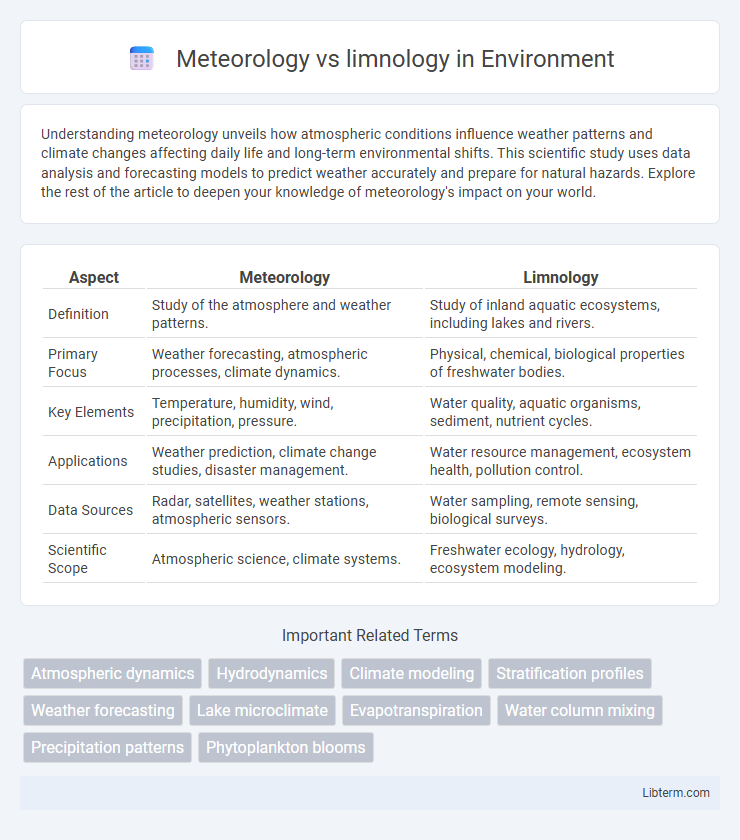Understanding meteorology unveils how atmospheric conditions influence weather patterns and climate changes affecting daily life and long-term environmental shifts. This scientific study uses data analysis and forecasting models to predict weather accurately and prepare for natural hazards. Explore the rest of the article to deepen your knowledge of meteorology's impact on your world.
Table of Comparison
| Aspect | Meteorology | Limnology |
|---|---|---|
| Definition | Study of the atmosphere and weather patterns. | Study of inland aquatic ecosystems, including lakes and rivers. |
| Primary Focus | Weather forecasting, atmospheric processes, climate dynamics. | Physical, chemical, biological properties of freshwater bodies. |
| Key Elements | Temperature, humidity, wind, precipitation, pressure. | Water quality, aquatic organisms, sediment, nutrient cycles. |
| Applications | Weather prediction, climate change studies, disaster management. | Water resource management, ecosystem health, pollution control. |
| Data Sources | Radar, satellites, weather stations, atmospheric sensors. | Water sampling, remote sensing, biological surveys. |
| Scientific Scope | Atmospheric science, climate systems. | Freshwater ecology, hydrology, ecosystem modeling. |
Introduction to Meteorology and Limnology
Meteorology studies the atmosphere, focusing on weather patterns, climate, and atmospheric phenomena, while limnology examines freshwater ecosystems such as lakes, rivers, and reservoirs. Introduction to meteorology covers concepts like atmospheric pressure, temperature, humidity, and wind dynamics that influence weather forecasting and climate science. Limnology introduces physical, chemical, and biological characteristics of inland waters, emphasizing nutrient cycles, aquatic habitats, and water quality assessment.
Definition and Scope of Meteorology
Meteorology is the scientific study of the atmosphere, focusing on weather processes, atmospheric phenomena, and climate patterns over short and long periods. It encompasses the analysis of atmospheric conditions such as temperature, humidity, wind, and precipitation, providing critical data for weather forecasting and climate research. Limnology, by contrast, centers on the biological, chemical, and physical characteristics of freshwater ecosystems, including lakes, rivers, and wetlands.
Definition and Scope of Limnology
Limnology is the scientific study of inland aquatic ecosystems, including lakes, rivers, reservoirs, wetlands, and groundwater systems, focusing on the biological, chemical, physical, and geological interactions within these freshwater environments. Unlike meteorology, which centers on the atmosphere and weather patterns, limnology encompasses the analysis of water quality, aquatic organisms, sediment processes, and hydrodynamics specific to freshwater bodies. The scope of limnology integrates ecosystem health assessment, water resource management, and the impact of human activities on freshwater habitats.
Core Differences Between Meteorology and Limnology
Meteorology is the scientific study of the atmosphere and weather processes, focusing on phenomena such as temperature, humidity, precipitation, and atmospheric pressure. Limnology, in contrast, centers on the study of inland aquatic ecosystems, including lakes, rivers, and wetlands, emphasizing water chemistry, biological communities, and ecological dynamics. The core differences lie in meteorology's atmospheric and weather-related focus versus limnology's aquatic environment and ecosystem analysis.
Key Research Methods in Meteorology
Meteorology relies on radar systems, weather satellites, and atmospheric models to analyze weather patterns and predict climate changes. Remote sensing and ground-based observations provide real-time data on temperature, humidity, and wind speed crucial for forecasting. These techniques contrast with limnology's emphasis on in-situ water sampling and aquatic ecosystem monitoring.
Key Research Methods in Limnology
Limnology primarily uses field sampling techniques such as water column profiling, sediment core analysis, and biological surveys to understand aquatic ecosystems. Advanced methods include remote sensing and in situ sensor deployments for continuous monitoring of physical, chemical, and biological parameters in lakes and freshwater bodies. Statistical modeling and experimental mesocosms are also key for studying nutrient cycling, hydrodynamics, and ecological responses in limnological research.
Practical Applications of Meteorology
Meteorology plays a critical role in weather forecasting, disaster management, and agricultural planning, providing essential data for climate prediction and resource management. It enables the monitoring of atmospheric conditions to improve aviation safety and optimize energy production from renewable sources like wind and solar power. Unlike limnology, which focuses primarily on inland aquatic ecosystems, meteorology offers broader practical applications that impact daily human activities and environmental policies.
Practical Applications of Limnology
Limnology provides essential insights into freshwater ecosystems, enabling effective management of lakes, reservoirs, and wetlands for water quality and biodiversity conservation. Practical applications include monitoring nutrient cycling, controlling algal blooms, and assessing pollutant impacts critical for fisheries and drinking water safety. Unlike meteorology, which focuses on atmospheric phenomena, limnology directly supports environmental remediation and sustainable freshwater resource management.
Career Opportunities in Meteorology and Limnology
Meteorology offers diverse career opportunities in weather forecasting, climate research, and atmospheric science, often leading to roles in government agencies, environmental consulting, and broadcast meteorology. Limnology careers focus on freshwater ecosystems, with positions in environmental monitoring, aquatic resource management, and research institutions dedicated to lakes and inland waters. Both fields provide pathways to scientific research, policy development, and environmental conservation, but meteorology typically involves broader atmospheric applications while limnology specializes in freshwater ecology.
The Future of Meteorology and Limnology Studies
Advancements in remote sensing and big data analytics are transforming the future of meteorology by enabling more accurate climate modeling and real-time weather prediction. Limnology is increasingly integrating molecular biology techniques and AI to monitor freshwater ecosystems, addressing challenges like pollution and climate change impacts. Collaborative efforts between meteorologists and limnologists enhance understanding of atmospheric-water interactions, crucial for sustainable environmental management.
Meteorology Infographic

 libterm.com
libterm.com